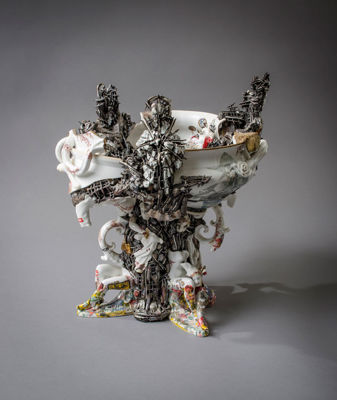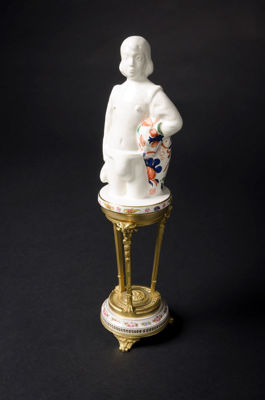Ceramics
Title: Big Soup Tureen
Ceramic and Mixed Media Provenance: Tory Folliard Gallery, Milwaukee, Wisconsin
Title: Billary
Satiral, gaudy; the work of Russell Biles has as much in common with a cheap souvenir as a sculptural artefact — levelling culture to take even swipes at celebrity, religion and politics. ‘Billary' riffs on the inseparable identity of the clintons, the slip cast figure literally joining the two as a totemic icon (traditionally emblematic of a specific tribe) hilst simultaneously suggesting that one is forever wearing the other as a token of identification.
Title: Binetsu
The running, vaporous form ‘Binetsu’ surmounts the limits of clay, Yosuke’s technical skill in hand-joining and connecting a series of puffy subdivisions finds a larger, more overarching biomorphic presence that gently rises and curls. The soft texture and simple white unglazed finish allow a calmness and rich interplay of shadow and definition upon the surface, and small organic apertures are encouraged or punctured through the shape to develop the sense of interaction in positive and negative space at different angles.
Title: Bird in the Man Tree Man
Earl’s hand-built ceramics concentrate on descriptive scenario, utilising landscape or building as an environment for laying out a storyline. Often focused on a recurring character named “Bill” and a likeness of rural Americana, Earl juxtaposes scenes with the romance and highly wrought fantasy of rococo porcelain, balancing folkiness with a sensual grandeur in a manner that often seems faintly surreal. The three-dimensional complexity of this work is typical
Title: Bites Will Not Trust Like Tough Love
Peruvian Kukuli Velarde makes work indebted to folk tradition and traditional ornamentation, exploring the new politics of identity, estrangements of context and acts of “forgetfulness” that occur as art is displaced from its origin. ‘Bites. Will Not Trust. Like Tough Love’ reveals itself as awakened in its situation, the mythic figure of half-bull, half-man caught uncertain, pulled from privacy, in its beautifully lifelike visage. The artist projects her own image onto the creature with the use of a head cast to reclaim the objects identity, and inherits and absorbs the (racially motivated) belittling title that reflects ongoing derogatory behaviour towards Latin America and its women.
Title: Black Fertility Vessel
Black Fertility Vessel with Cast Elements Marsh studied at Shimaoka Pottery with Tatsuzo Shimaoka whom Japan named a Living National Treasure in 1996 (see lot 4). From 1978 to 1981 Marsh worked for Shimaoka as a student and apprentice. However when it came to his own vision he did not follow the Japanese style. Rather he made his vessels more open and carefully placing slip-cast elements of nature in their interiors. Marsh is currently the chair of ceramics, California State University in Long Beach and is exhibited in the USA as well as internationally.
Title: Black Pod
Kelley Eggert utilizes hand building techniques to create her other-worldly yet recognizable forms that combine plant and insect elements into one sculptural hybrid. The resulting piece induces a sense of wonder and curiosity as to the function and existence of the newly formed creature. “Black Pod” was created using coiled ropes of clay that are low-fired with an underglaze and luster and then finished with acrylic paint. Strongly influenced by the natural world, Eggerts work is an exploration of how the natural differs, relates to, and is influenced by the “unnatural” human world.
Title: Blue and White Flower
Reflecting the co-existence of chaos and beauty in nature, Zemer Peled’s form remarks on a sense of place and movement that feels simultaneously delicate and violent. Each shard is made by rolling out large sheets of clay which are glazed, fired — then smashed with a hammer to create fragments holding a vestige of material fragility and edged with a new razor-sharp sense of that point of destruction, and the hint of further menace that the barbs of a land or sea creature might imply. Construction of porcelain shards
Title: Blue Dots
“Blue Dots” reflects Nakashima’s interest in Sōdeisha, a movement among Japanese ceramicists working in the 1940s through 1950s that embraced biomorphic, sculptural forms over craft-inspired, functional ones. The work features a series of tumescent forms that swell from the surface of a gently curved slab of porcelain. It was hand-built, an impressive achievement given its irregular, bulging forms. Nakashima plays with positive and negative space–the work curves in and out to create shadowy crevices and thin voids that are contrasted against the object’s luminous convex surfaces. Blue dots expand and contract in scale to create a heightened sense of depth and fluid movement. Nakashima’s use of cobalt blue over-glaze recalls the Japanese sometsuke tradition.
Title: Blue Dots No. 0403
“Blue Dots” reflects Nakashima’s interest in Sōdeisha, a movement among Japanese ceramicists working in the 1940s through 1950s that embraced biomorphic, sculptural forms over craft-inspired, functional ones. The work features a series of tumescent forms that swell from the surface of a gently curved slab of porcelain. That the piece was hand-built is an impressive achievement given its irregular, bulging forms. Nakashima plays with positive and negative space–the work curves in and out to create shadowy crevices and thin voids that are contrasted against the object’s luminous convex surfaces. Blue dots expand and contract in scale to create a heightened sense of depth and fluid movement. Nakashima’s use of cobalt blue over-glaze recalls the Japanese sometsuke tradition.
Title: Boa Swallowed the Rabbit
Surface informs design in Romule pottery, ‘Boa Swallowed The Rabbit’ expressing a moment of absorption where two forms unite, the bulging central container of the teapot spun as the mass of rabbit ingested by the snake in erotically charged typology. Romule finds much of her figural narrative through the elegantly painted exteriors of her porcelain, compressing perspective and storied symbolism into the material whilst developing simple figural motif — such as the snake spout & handle.
Title: Botany No. 95-21
From the “Botany” series, this sculpture wrests for an interpretive form derived from nascent plant or organ-like shapes. Kuo often attempts to capture and study similarly aligned responses from disparate elements and cultures in his art, seeking materials that might adequately transform into or convey a loose and hypnagogic bodily form.
Title: Bread Frog Making a Pig of Himself
The eccentric Gilhooly makes a series of work dedicated to the character of bread frog, seeking to ‘break out’ of fated roles (whatever that might be for the frog is never fully clear, other than to be eaten) and reassume identity. Here the bread frog becomes gluttonous pig, grotesquely greedy — actually assuming the identity through a glossy piglike mask. Gilhooly’s sculpting of clay is consistently delightful in its oddity and personable realisation, such bright use of colour through application of acrylic varnish giving the piece a novelty and eye-catching attraction.





































